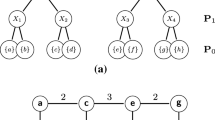Abstract
A major drawback when using the watershed transformation as a segmentation tool comes from the over-segmentation of the image. Over-segmentation is produced by the great number of minima embedded in the image or in its gradient. A powerful technique has been designed to suppress over-segmentation by a primary selection of markers pointing out the regions or objects to be segmented in the image. However, this approach can be used only if we are able to compute the marker set before applying the watershed transformation. But, in many cases and especially for complex scenes, this is not possible and an alternative technique must be used to reduce the over-segmentation. This technique is based on mosaic images and on the computation of a watershed transform on a valued graph derived from the mosaic images. This approach leads to a hierarchical segmentation of the image and considerably reduces over-segmentation.
Then, this hierarchical segmentation is redefined by means of a new algorithm called the waterfall algorithm. This algorithm allows the selection of minima and of catchment basins of higher significance compared to their neighborhood. A very powerful implementation of this algorithm using geodesic reconstruction of functions is also presented.
Finally, this approach is compared to another powerful tool introduced by M. Grimaud for selecting significant extrema in an image: the dynamics.
Access this chapter
Tax calculation will be finalised at checkout
Purchases are for personal use only
Preview
Unable to display preview. Download preview PDF.
Similar content being viewed by others
References
S. Beucher: Segmentation d’Images et Morphologie Mathématique, Doctorate Thesis, Ecole des Mines de Paris, June 1990.
S. Beucher and F. Meyer: “The morphological approach to segmentation: the watershed transformation”, in: E. Dougherty, ed., Mathematical Morphology in Image Processing, Marcel Dekker Inc, 1992, pp. 433–481.
M. Grimaud: La géodésie Numérique en Morphologie Mathématique. Application à la Détection Automatique de Microcalcifications en Mammographie Numérique, Doctorate Thesis, Ecole des Mines de Paris, Dec. 1991.
Author information
Authors and Affiliations
Editor information
Editors and Affiliations
Rights and permissions
Copyright information
© 1994 Springer Science+Business Media Dordrecht
About this chapter
Cite this chapter
Beucher, S. (1994). Watershed, Hierarchical Segmentation and Waterfall Algorithm. In: Serra, J., Soille, P. (eds) Mathematical Morphology and Its Applications to Image Processing. Computational Imaging and Vision, vol 2. Springer, Dordrecht. https://doi.org/10.1007/978-94-011-1040-2_10
Download citation
DOI: https://doi.org/10.1007/978-94-011-1040-2_10
Publisher Name: Springer, Dordrecht
Print ISBN: 978-94-010-4453-0
Online ISBN: 978-94-011-1040-2
eBook Packages: Springer Book Archive




